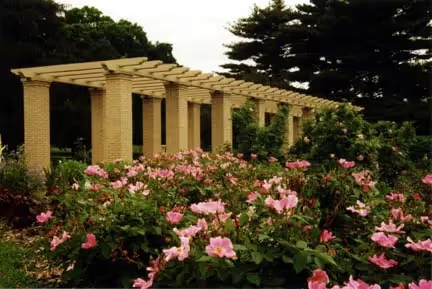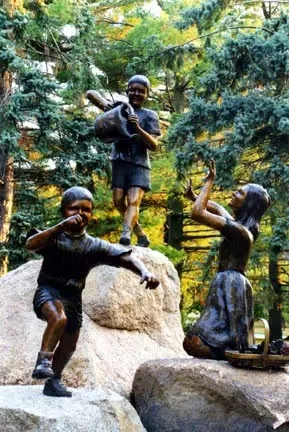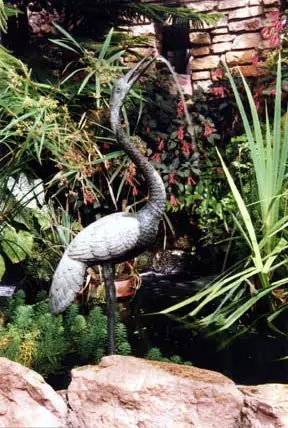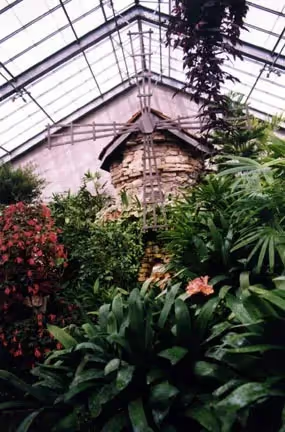A biweekly newsletter with public space news, resources, and opportunities.
A curated dispatch on all things public markets plus the latest announcements from the Market Cities Program.
Please note that these Hall of Shame nominations were written in a moment in time (most over a decade ago) and likely have since changed or even been transformed. If the above entry is now great, or still not so great, go ahead and comment below on how it has evolved or nominate it as a great place.

A multi-use park that evolved from farmland (1865) to fairgrounds (1867) to city park(1885).

On the south bank of the Mississippi River, where it runs east to west is the city of Davenport, Iowa, one of "Quad Cities" (two in Iowa, two in Illinois). Two miles north of the river and the downtown environs of Davenport is Vander Veer Botanical Park, gently sloping 33.8 acres of land that metamorphosed from farmland in 1865, to fairgrounds in 1867, to City Park in 1885 with naturalistic design by Olaf Benson, a landscape engineer from Chicago. The park maintains that design and is home to a collection of more than 600 trees represented by over 70 species, some over 100 yrs old. Maps and brochures are available to those who want to identify the location and name of each and every tree.
There are gardens, i.e. Old World Gardens featuring annual beds of the style popular in many European countries of the 19th century, a reminder of the German heritage of many of Davenport's early settlers; the Municipal Rose Garden at the SW side of the park - an All-America Rose Selections garden, under a pergola with fountain; the Hosta Glade which includes varieties of hosta, companion plants, and spring woodlandwildflowers; the Children's Sculpture Garden - a setting for life-sized sculptures of children playing amid the surrounding flowers; the All-America Selections Display Gardens of flower and vegetables.
In addition to the trees and gardens, there are beds: The Circle Bed, one of two original roadway beds, featuring plants popular in Victorian gardens; the Conservatory Entrance Bed, a texture garden with annual color; the Parking Lot Perennial Island Bed with seasonal display of perennial plants and flowers; the Grand Allee Planting Beds, a teaching collection containing nine pairs of planting beds at both sides of the walkway, i.e. transitional shade garden, songbird garden, spring and fall color garden, hummingbird garden, heat-tolerant garden, grass garden, midsummer blooms garden, sensory garden, and butterfly garden. Other attractions include: a one-surface-acre, fish-stocked lagoon with two constantly spewing fountains and a treed island in the center. The island is an attraction to many wild ducks that nest there, and the ducks attract the many people who want to watch and feed them. The fish are provided, again just for watching, or for catch-and-release fishing. Nearby is a plaque explaining the ecosystem of the lagoon, and adjacent is the warming house, used in the winter when the lagoon becomes an ice-skating rink, open to all, and the site of the annual Silver Skates children's ice-skating races. There is the Grand Allee, a brick-paved walkway, running North to South, beginning in front of the Conservatory and culminating in front of a large stone fountain, currently under renovation. The Grand Allee is patterned from photos taken at the park at the turn of the century and includes recessed benches and the garden beds named above, lined in its entirety by a double row of trees, pin oaks closest to the walkway, and tulip trees in the outside row. It is lighted along its entire length by lampposts, circa 1900. Another popular attraction is the sculpture, Majestic Hope, carved by a local artist, Tom Gleich, from a large, old sycamore tree that was scheduled for removal after being irreparably damaged in a storm. Tom approached the Parks and Recreation Dept. and offered to carve a sculpture from the remains of the tree, gratis. The results of his talent and effort is a mammoth, graceful, to-scale sand crane, a waterfowl commonly found along the Mississippi River waterways. It is surrounded by plantings that are complementary to its size and environs, and is highly visible to all who travel the four-lane northbound Brady Street, and to the many that walk, run, or jog along the city sidewalks surrounding the park. There is a children's play area with slides and structures for climbing and bridge-walking, located near the lagoon and one often can see children dancing from the play area to feed the ducks, and then back again for more conventional forms of play. Or, they may go inside the conservatory to learn how to plant in a sneaker. There is the conservatory, which also serves as the education complex. It consists of a gift shop and three growing houses: cold, warm, and tropical. The Conservatory is open year-round to view seasonal floral displays, i.e. chrysanthemums from October to Thanksgiving, poinsettias from Thanksgiving to New Year, followed by azaleas, forced hyacinths, tulips, daffodils, and cinerarias from late winter throughout spring. By April three types of lilies are featured. Flowering plants are brought into the Conservatory weekly, forming three distinct displays at any one time.
Vander Veer is situated in an established neighborhood, making it easy for anyone in that neighborhood to go there on foot. Brady and Harrison Streets, the two main traffic arteries linking to downtown Davenport, are both on city bus routes. Park entrances and exits are on the north side, off Central Avenue, and those converge into a single, wide road that meanders throughout the inside perimeters of the park.
Just to drive by is a good first impression, but when one enters the park, either on foot or in a car, its natural beauty is immediately evident. Vander Veer is open daily from sunrise until one-half hour after sunset. Its central location, high visibility, and openness discourage daytime crime, and the city police drive through the park regularly after hours to ensure that it remains crime-free after dark. The park is always litter-free. Those who use the park, for the most part, dispose of their own litter in judiciously placed receptacles for that purpose. It is also serviced in this regard by gardeners constantly at work there, by the City Parks and Recreation Department, and by an organization known as AMPS (Area Maintenance Persons - a local group of retired maintenance personnel), along with other volunteers. Cars are inconspicuous, whether parked or driving through the park.
This park is friendly to families, groups, and loners. On any given day, at any given time (dictated only by the weather) one can see people of all walks of life and all ethnicities, people who live in Davenport and those who visit the city. People are sitting on benches, watching their children at play; or, they may be working persons who have come there to spend their lunch hour in a less hectic environment. They may be readers, poets, or dreamers. People come there simply to stroll the grounds and enjoy all the beauty around them. People come there to sunbathe in the green space or to play Frisbee or catch, or perhaps have a ground picnic. More active persons can bicycle or in-line skate on the macadam-surfaced road that meanders throughout the park. Little League Baseball and Midget Football teams use the green space for practice. One may see people walking their dogs, pushing strollers or wheelchairs, or simply gathered in small groups to chat. The park is a magnet for walkers, runners, or joggers year-round. They can do this inside the park or on the city sidewalks around its perimeters. Seven times around the park is five miles; the pros know this, the others don't care.
Planned tours and outings are encouraged. For example, this spring, in two months' time, 57 busloads of kindergarteners came to the park to look and learn. They may have returned to their schools deciding to enter the My Favorite Tree contest with entries by poster, poem or essay.
The rose garden is the scene of many weddings. If the weather is uncooperative, the wedding can be held in the Conservatory, perhaps in the room with the stone windmill and pond of koi. No need to hire a florist. There are planned activities also - festivals and family events, like the Silver Skates races in January, the annual Garden Walk in the summer, musical evenings in the park with band concerts, and the Fall Festival each September, to name a few.
Sociability is part of all the information offered above. This city park is much loved and used by Davenport citizens, and they are proud to show it off to visitors.
The use of Vander Veer Botanical Park goes beyond its geographical borders and is a viable part of the park and its mission. For instance, one can earn a Certificate in Home Horticulture by participating in a 70-hour program with many basic topics of study and a wide variety of special-interest elective classes with practical applications and hands-on learning. Instructors include local horticulture experts and Iowa State University and Extension staff. Another example is the Garden Growers, a not-for-profit organization that was formed locally to introduce and support community gardening in the Quad Cities. Anyone can call who is interested in starting a community garden. If there is a vacant city lot or other land available for public use in the caller's neighborhood, volunteers and staff persons from several participating agencies, including Vander Veer Botanical Park, will go to that neighborhood and help those people start it. They will also be on-call to answer questions about maintenance and harvest. Their mission is to develop a community gardening program that promotes education, social interaction, and beautification in neighborhoods. Vander Veer is not a static park. Current and future plans include restoration of the Stone Fountain at the south central end of the park. The long-dormant original base of the tall fountain that was there in the early days of the park in the last century is still there. It will have a circulating water spray and changing lights, and will be surrounded by seating. The next plan in the works is to reconstruct a band shell. Seating will be as it is now, in lawn chairs or on the ground. Also planned is a watershed system, not only for fun and beautification, but also for teaching a system of ecology. It will begin with a wading pool toward the SE side of the park and form a draining system that will lead to a wetlands area, with appropriate plantings, at the east side, and from there to the lagoon on the North. A stone bridge (also original to the park site) is already there to accommodate pedestrians wanting a close look at the wetlands. All of these amenities can only add to the already wonderful ambience of this park, and are placed with great care and the certainty that future generations for a long, long time can enjoy and use them. There is a nice balance between the preservation of the past and dynamics of the present - a spirit of the place that reflects a sense of community, who we are now and where we came from. Though tranquil on the surface, there's an undercurrent of energy that is evidenced by the park itself, the people who maintain it, and those who use it. Vander Veer Botanical Park is a place that is an oasis of serenity in the midst of the busy world of commerce. It is a place that invites you to meet and greet, to relax, to think, to talk, to do something or nothing. It is a clean and beautiful place where you feel safe - a place to go to recall and reflect on your place in the greater scheme of nature, to stimulate your senses and renew your spirit.








*Please note that these Hall of Shame nominations were written in a moment in time (most over a decade ago) and likely have since changed or even been transformed. If the above entry is now great, or still not so great, go ahead and comment below on how it has evolved or nominate it as a great place.